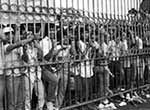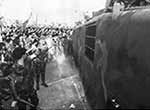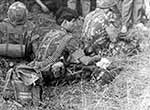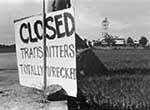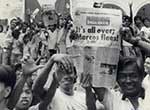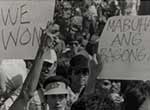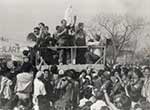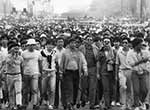LIFESTYLE
ENTERTAINMENT
BUSINESS
TECHNOLOGY
OPINION
GLOBAL NATION
And so it was in the beginning when Edsa was just a highway that cut across Metro Manila on which people passed through on their way to their destinations. Its sides were strewn with vast grasslands. No malls and shrines stood along it and no elevated trains ran overhead. But four days in February 1986 changed all that.

Presidential candidate Corazon C. Aquino speaks to supporters during a campaign.
President Ferdinand Marcos bares a coup plot led by Defense Minister Juan Ponce Enrile.
The Beginning
It all began with a call for a snap election by then President Ferdinand Marcos on Nov. 23, 1985, amid mounting protests against his 20-year rule.
The opposition responded by uniting behind one candidate, Senator Benigno Aquino Jr.’s widow, Corazon, or “Cory,” who carried the torch of freedom for her husband after his assassination on Aug. 21, 1983.
Fidel Ramos, chief of the Philippine Constabulary and Defense Minister Juan Ponce Enrile withdraw support from the Marcos government.
Media provide situationer in Edsa as people gather in protest against the Marcos regime.
His Eminence Jaime Cardinal Sin calls for support for the rebels.
The Uprising
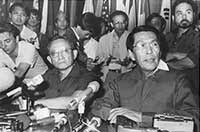
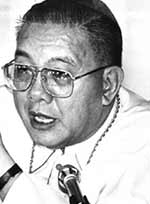
The four-day uprising, which began Feb. 22, was dubbed the first “people power revolt” where the battle was fought with food, flowers and prayers instead of guns.
Corazon C. Aquino is sworn into office as Philippine president by Chief Justice Raul Teehankee on Feb. 25, 1986.
The Fall
On the fourth day of the revolution, Feb. 25, there was eager anticipation as word began to spread that Marcos and his family would leave the country.
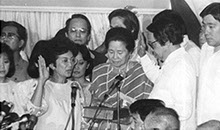
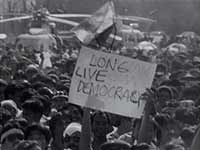
President Corazon C. Aquino at the US Congress on Sept. 18, 1986.
President Aquino reads a poem by martyred Sen. Benigno Aquino Jr.
Edsa & Beyond
Many changes have happened since the first people power revolt in Edsa. Barely warming her seat as president, Aquino was tested as she fought off seven coup attempts during her six years in power from the people who supported her in Marcos’ ouster. And with the Filipinos’ penchant for the “teleserye,” the first revolt was soon followed by a second one in January 2001, which ousted then President Joseph Estrada and installed his Vice President, Gloria Macapagal-Arroyo.
A third revolt, albeit smaller, and unsuccessful, happened four months after, in April, when Estrada loyalists stormed Malacañang in an attempt to re-install the former actor-turned-politician. Today, a statue of the Blessed Virgin Mary, to whose intercession the protesters in the first people power revolt attributes the country’ peaceful transition from dictatorship to democracy, now stands tall on a religious shrine fronting a mall and across a Metro Rail Transit System.
Edsa was also where former President Corazon Aquino bid her final farewell as she brought thousands of people back on the streets one last time on Aug. 3, 2009.
The Edsa of 1986 is but a shadow of the Edsa in 2014. But the legacy that the first people power revolt left behind is long and lasting. The late Corazon Aquino said it best in her speech before the joint session of the US Congress in Sept. 18, 1986, seven months after she was installed president: “Three years ago, I left America in grief . . . . Today, I have returned as the president of a free people.”
Are you an Edsa baby?
(Thank you for reading our special site “INQBack: Edsa 28. Find out how much of an Edsa baby you’ve become by answering the 10 questions INQUIRER.net has prepared for you. Learn and remember.)
With reports from:
Photos:
Audio clips:
The Philippine Daily Inquirer
INQUIRER.net
Nestor Corales
Bong Lozada
Kristine Angeli Sabillo
The Philippine Daily Inquirer
RTVM
Noy Morcoso - INQUIRER.net
Radio Veritas c/o The Philippine Daily Inquirer
